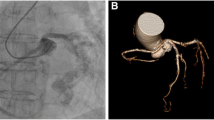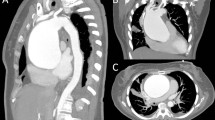Abstract
Apicoaortic bypass (AAB), or apicoaortic conduit insertion, is a conventional surgical method that has been regaining attention due to the aging population and the increasing number of repeat surgeries. The indication for the procedure has been extended as an alternative for aortic stenosis when the usual sternotomy or aortic clamping is considered to be difficult, e.g., in patients with severe calcification of the ascending aorta (porcelain aorta), or in patients with a patent coronary artery bypass graft located adjacent to the posterior surface of the sternum. Herein, we report our recent anesthetic management of three patients undergoing AAB. Once the apicoaortic conduit is inserted, blood from the left ventricle is ejected via two routes, the narrowed native aortic valve and the apicoaortic conduit. Thus, it is necessary to elucidate any change in blood flow after the withdrawal of the extracorporeal circulation, by using intraoperative transesophageal echocardiography. Furthermore, if a rigid apical connector is not used, anastomosis of the cardiac apex and conduit is conducted under ventricular fibrillation without the infusion of cardioplegic solution; thus, patients are deemed likely to suffer increased myocardial damage. As a rigid apical connector was not used in the three present patients, the administraction of adequate catecholamines was needed for the withdrawal of the extracorporeal circulation. In addition, because those undergoing AAB often have extremely poor cardiac reserve preoperatively owing to the administration of adequate catecholamines was needed for the withdrawal of the extracorporeal circulation. In the three present patients, anesthetic management was successful, and there were no intraoperative or immediate postoperative complications.
Similar content being viewed by others
References
Cooley DA, Lopez RM, Absi TS. Apicoaortic conduit for left ventricular outflow tract obstruction: revisited. Ann Thorac Surg. 2000;69:1511–1514.
Lockowandt U. Apicoaortic valved conduit: potential for progress? J Thorac Cardiovasc Surg. 2006;132:796–801.
Nishimura Y, Okamura Y, Hiramatsu T, Iwahashi M. Apicoaortic valved conduit is a good alternative for aortic stenosis with porcelain aorta after off-pump coronary artery bypass grafting. Interact Cardiovasc Thorac Surg. 2007;6:374–375.
Cooley DA, Norman JC, Mullins CE. Left ventricle to abdominal aorta conduit for relief of aortic stenosis. Cardiovasc Dis. 1975;2:376–383.
Chumnanvej S, Wood MJ, Macgillivary TE, Vidal Melo MF. Perioperative echocardiographic examination for ventricular assist device implantation. Anesth Analg. 2007;104:583–601.
Fogel MA, Rychik J, Chin AJ, Hubbard A, Weinberg PM. Evaluation and follow-up of patients with left ventricular apical to aortic conduits with 2D and 3D magnetic resonance imaging and Doppler echocardiography: a new look at an old operation. Am Heart J. 2001;141:630–636.
Gammie JS, Krowsoski LS, Brown JM, Odonkor PN, Young CA, Santos MJ, Gottdiener JS, Griffith BP. Aortic valve bypass surgery: midterm clinical outcomes in a high-risk aortic stenosis population. Circulation. 2008;118:1460–1466.
Matsuyama K, Narita Y, Ueda Y. Apicoaortic valved conduit without an apical connector. Gen Thorac Cardiovasc Surg. 2007;55:370–371.
Fujii Y, Kanki K, Mitsui H, Ishino K, Izumoto H, Sano S. Apicoaortic bypass using a vascular graft with a bioprosthetic valve. Gen Thorac Cardiovasc Surg. 2007;55:240–242.
Vassiliades TA. Off-pump apicoaortic conduit insertion for highrisk patients with aortic stenosis. Eur J Cardiothorac Surg. 2003;23:156–158.
Takeda K, Matsumiya G, Takano H, Koh M, Iwata K, Sawa Y. Unusual thrombus formation in the aorta after apicoaortic conduit for severe aortic stenosis. J Thorac Cardiovasc Surg. 2006;132: 155–156.
Renzulli A, Gregorio R, De Feo M, Ismeno G, Covino FE, Contrufo M. Long-term results of apico-aortic valved conduit for severe idiopathic hypertrophic subaortic stenosis. Tex Heart Inst J. 2000;27:24–28.
Author information
Authors and Affiliations
About this article
Cite this article
Ogawa, S., Okutani, R., Shigemoto, T. et al. Anesthetic management of apicoaortic bypass in patients with severe aortic stenosis. J Anesth 23, 427–431 (2009). https://doi.org/10.1007/s00540-009-0768-x
Received:
Accepted:
Published:
Issue Date:
DOI: https://doi.org/10.1007/s00540-009-0768-x




